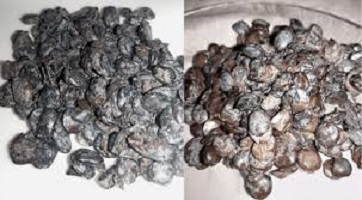Iru Recipe – African Fermented Locust Beans
Iru Recipe – African Fermented Locust Beans

It’s a fragrant local seasoning that’s widely used in West African soups and stews. Yorubas call it “iru,” Igbos call it “ogiri,” Hausas call it “dawadawa,” and the Edos call it “iru” or “eware.” The locust beans used to make this seasoning are grown on an African perennial deciduous tree.
Iru (Fermented Locust Beans) has been consumed in West Africa for centuries because of its delectable taste and health benefits.
It adds a deep umami flavor to savory and sweet dishes and is high in protein and natural fats.
A Must Read >>>
Table of Contents
These are amazing health benefits of Iru (African locust bean)
- Anti-oxidant Properties.
- Dermatological Properties
- Treatment of Respiratory Infections
- Treatment of Gastrointestinal Disorders
- Wound Healing Properties
- Treatment of Hypertension and Boosts the Immune System
Iru Recipe
Iru (Fermented Locust Beans) seeds are fermented and used to make a flavorful condiment for seasoning sauces, stews, and soups.
On your spice rack, Iru is the funky, fermented flavor bomb you’ve been looking for.
We’ve included instructions for making Iru seasoning – Fermented Locust Beans below.
Iru Recipe: Ingredients for Iru – Fermented Locust Beans
- African locust bean seed
- Water
Special Utensils
- Mortar
- Pestle
- Fabric bag
Steps to prepare Iru – Fermented Locust Beans
- Firstly, pound or crush Iru seeds and pulp in a mortar with a pestle to separate the seeds from their covering.
- Secondly, dry the seeds for one day in the sun. Then, remove any chaff from the Iru seeds that may have gotten into the mix.
- After that, place the seeds in a saucepan with the water and bring to a boil. The seed will become soft, allowing you to separate the seed coat from the seed.
- Then, add wood ash and pound for a few minutes more before drying the seeds in the sun.
- Now, remove the seed coat from the Iru seeds by sifting them again and rinse the seeds once more to remove any remaining wood ash.
- Re-boil the seeds for two hours, then drain the water and store them in a fabric bag. Squeeze out any excess water.
- Lastly, leave the seeds for about 3 days, or until they are completely fermented.
You can roll it into small balls and use them whenever you want.
FAQ on Iru Recipe
Is it necessary to wash iru before cooking?
Iru (dawa dawa) is a spice that is used to flavor stews, sauces, and other meals such as rice and local salads.
Because there may be stone or sand residue from the conventional processing procedure, it’s vital to wash fermented locust beans before using them.
What’s the best way to prepare locust beans? Iru Recipe
Method
- Firstly, rinse the locust beans and set them aside.
- Secondly, blend your sauce in a blender until it is coarsely blended and leave aside.
- After that, melt the palm oil in a pan over medium heat. Allow 2 minutes for the mixture to heat up.
- Then, gently stir in the chopped onions and sauce. Allow for 2 to 3 minutes of cooking time after covering the pot.
- Stir in the seasoning cube, crayfish (if using), salt, and locust beans, and simmer for another 5 minutes.
- Lastly, after 5 minutes, carefully mix in the fish and turkey. Remember to taste and season with extra salt and spice if necessary. Cook for another 5 minutes with the lid on.
Viola
What’s the best way to make iru? Iru Recipe
Soy-iru is traditionally made by boiling soybean seeds in water, then dehulling, simmering in boiling water, and fermenting in a calabash.
The traditional fermenting container, calabash, is rapidly becoming obsolete, necessitating the use of a plastic substitute.
What are your favorite ways to use iru?
Soak in boiling water to soften, or add to soups and stews like you would dry mushrooms or other dried natural sources of glutamates.
Iru, along with garlic, onions, and other aromatics, should be added to sautéed foods at the start of the cooking process.
What is the English equivalent of the word iru?
The locust bean, also known as iru in Yoruba and ‘ogiri’ in Igbo, is a native spice or condiment used in soups and stews.
It is known as African locust bean in English and has the scientific name Parkia biglobosa. It is a highly popular soup component all around the world.
How to use dried iru
Soak in boiling water to soften, or add to soups and stews like you would dry mushrooms or other dried natural sources of glutamates.
Iru, along with garlic, onions, and other aromatics, should be added to sautéed foods at the start of the cooking process.
Iru substitute – Is there anything else I could use instead of locust beans?
What may be used in place of locust beans? One of the major components is locust beans, however if you can’t find locust beans, use dawadawa or ogiri instead.
What is the taste of iru?
It’s a fermented bean from the Nigerian Locust Tree that boasts a taste that’s something between chocolate, miso, and cheese.
What is iru seasoning?
Iru, also known as Eware (Edo), is a condiment made from fermented and processed locust beans (Parkia biglobosa).
It’s a cross between ogiri and douchi. It is extremely popular among Nigeria’s Yoruba and Edo peoples.
Traditional soups like as egusi soup, okro soup, Ewedu soup, and ogbono soup are made with it.


